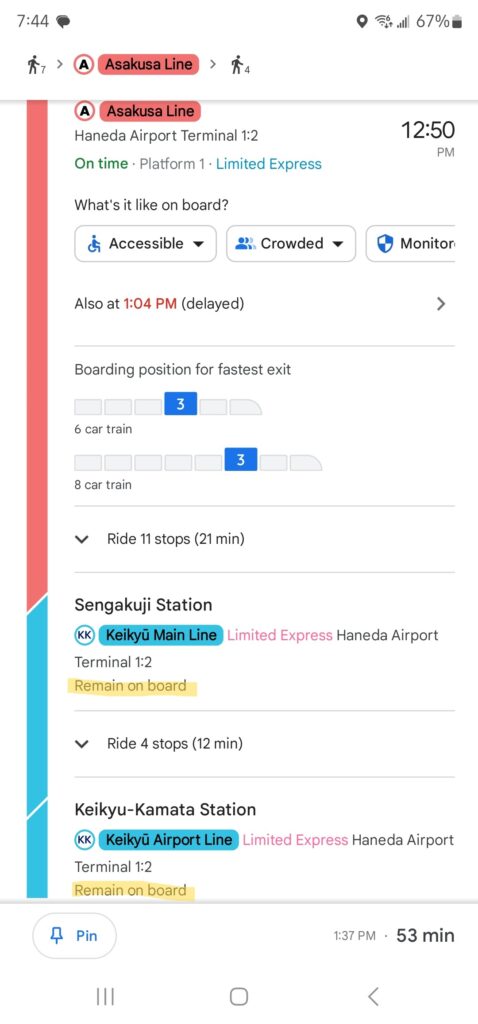When NOT To Trust Google Maps In Japan
When traveling most anywhere in the world, nothing is more useful than Google Maps. The ability to provide directions in a totally foreign environment cannot be understated! It’s something we take for granted in this day and age but Google Maps is a lifeline when traveling. I cannot imagine trying to get around without it. That’s also including domestically!
In a country like Japan with its vast infrastructure, which you’ll no doubt be using quite often, Google Maps in Japan is a true lifesaver. With it listing all the different subway lines, the platform the subway line will be on, when to get off and transfer to another line, what exit to use, it’s all extremely, extremely useful.
99% of the time you can mindlessly follow the directions and not even really think twice about it. There are certain occasions where, if you aren’t paying attention, can lead to some delays or confusion while using the subways.
I ran into this a couple times while traveling in Japan. I thought I’d write something to help others out who may be traveling to Japan.
When Google Maps Can Get Confusing
Example #1
One example is below from Tokyo:
This was my route when I was on the way to the airport to fly home:

It seems pretty straight forward. Only one line is listed – the Asakusa Line. BUT the confusion lies (at least for myself) with the highlighted “Remain on board”.
The overall directions tell you to stay on board when you get to Sengakuji Station. But it also lists the Keikyu Main Line.
The overall directions don’t list this, stating only the use of the Asakusa Line. Does the Asakusa line turn into the Keikyu Main Line? Do you need to exit the subway and get on another platform to catch the Keikyu Main Line?
Fortunately, this was the tail end of the trip for me. At this point I was always on alert when Google Maps said to “Remain on board”, which I’ll explain below.
The Japan subways do an excellent job of making announcements calling out what lines you can transfer to as you approach each station. They also make announcements in English.
If you aren’t paying attention, or are just staring at Google Maps, it’s pretty easy to miss these call outs though.
Fortunately from past experience, I was definitely paying attention on this trip and was able to hear that the Keikyu Main Line was indeed a totally separate line which required me to leave the Asakusa line. The same for the Keikyu Airport line. This was a separate line than the Keikyu Main Line.
If I hadn’t been paying attention I would have stayed on the Asakusa line and then figured out I was supposed to transfer to those other lines after a few more stops. I would have had to back track and get back on course.
That’s a pain in the butt and time consuming. Especially with me needing to catch a flight.
Example #2
For this example I don’t have a screen shot of the directions. However, this happened in Osaka on the Osaka Loop Line, which JR West operates. It runs in both a clockwise and counter clockwise loop and hits 19 stations. It’s a very useful line to use while in Osaka.
Similar to my previous example, Google Maps told me to take the Osaka Loop Line and to stay on board at a certain station. Unlike the first example there were no other subway lines listed at all. It appeared that I should remain on board when the train stopped. This time I wasn’t paying attention to the announcement at all figuring that after this stop the train would continue on its clockwise journey.
This wasn’t the case. After sitting on board for about five minutes the train departed…but in the direction it had come from.
It was an easy correction. I got off at the first stop and refreshed Google Maps and re-boarded the correct line. There were a few other tourists on board who most likely were using Google Maps as well who did the same thing I did.
Takeaways
- If you see a totally different subway line listed on the Google directions and it’s telling you to “stay on board”, than really pay attention to the announcements. Like I mentioned, there will be an announcement made prior to every station stop about what lines you can transfer to at what station.
- If you missed the announcement (sometimes it can be noisy and you might not hear or may not have been paying attention) you can always get off at the station in question to get your bearings.
- New subway trains come by quite frequently and you can always hop on and off to figure things out.
- The lesson from Example #2 is if the train stops for an abnormal amount of time, most if not everyone gets off board, then you should most likely double check / refresh Google Maps or exit the train entirely and make sure the directions are correct.
- Also, don’t be afraid to ask! People in Japan are incredibly friendly and helpful and will likely help point you in the right direction.
The Japan subways are really amazing and incredibly helpful to shuttle you around the city. They can be overwhelming initially but in due time you grow accustomed to them and gain a better understanding of what Google Maps in Japan is telling you. You got this!




